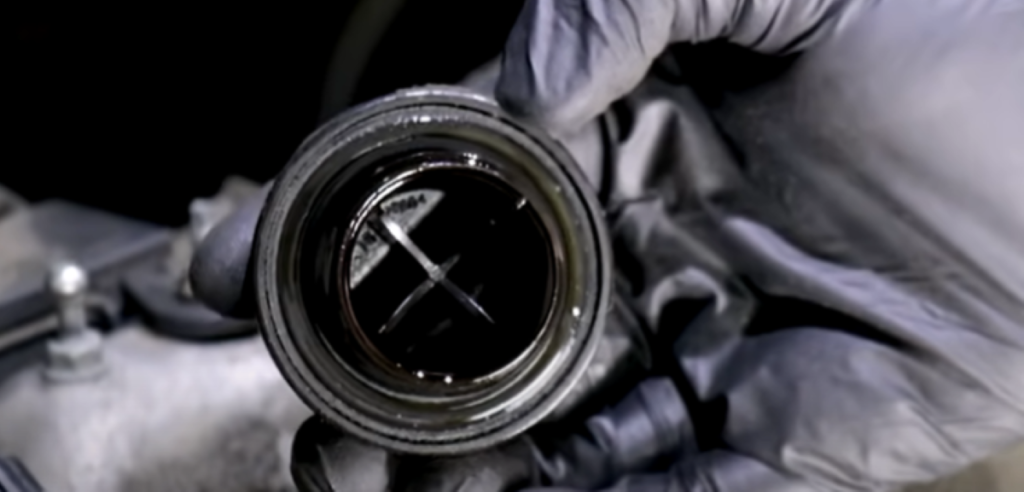If you know your car is leaking oil when parked, this guide and video shows you what to do and what to check under the hood to help you find an oil leak in your car.
How to Find an Oil Leak in Your Car

How to find an oil leak in your car
- Wear Hand and Eye Protection
Safety is important. Wear hand and eye protection while looking to find out why your car is leaking oil.
- Open the Hood, Remove the Oil Cap, and Check the Top of the Engine and Any Sensors for Oil Leaks
Open the hood. Under the hood, look at the top area of the engine. If oil is leaking along the top of the engine, it will drip down. Check the engine for leaking oil and streaks or drips of oil.
Remove the oil cap. Check the oil cap’s seal and for tearing, looseness, or broken pieces. Make sure it’s in good condition. Check around the rim of the oil fill hole for a puddle of oil, which means it is probably leaking.
Along the top of engine there are different sensors. See if any are leaking where they connect to the engine, which is a sign of an oil leak.
- Check the Valve Cover Gasket for Oil Leaking
The valve cover gasket sits between the valve cover and the engine. If it’s leaking oil, you’ll see it leaking from the cover down along the engine. If the exhaust manifold is below it, it may be burning oil off and you’ll be able to smell it.
The valve cover gasket may not be leaking but seeping oil. A seep is not considered a leak and not something that needs to be fixed unless it’s causing engine oil levels to drop too low, but if oil is dripping down the engine and onto the ground, you can consider it a leak and will have to replace the gasket.
- Lift the Car and Check Underneath It and the Backside of the Engine
Look for a puddle of oil under the car, which is an obvious and common sign of an oil leak. Check underneath the vehicle for oil stains on parts, which is a sign oil has been leaking.
Inspect the oil pan. The gasket between the oil pan and the engine can sometimes leak.
Check the oil filter housing for leaks. The oil filter could leak if it wasn’t torqued to spec. Over and under-tightening the oil filter can cause an oil leak. - Check All Sides of the Engine for Oil Leaking
Look along the front, backside, and sides of the engine for oil leaking.
Remove the shield from the wheel well for better access to the engine.
Look for oil leaking on parts like the timing chain tensioner, serpentine belt pulleys, or a sensor down along the crank. If oil is leaking onto these areas and moving parts, it will probably spray all over and you’ll find oil all over the place. - Check the Oil Level
Get underneath the hood and check the oil level. Remove the oil dipstick and wipe it clean with a shop cloth. Reinsert the dipstick and remove it. Check the engine oil’s level and condition. The level should read in between the two markers. If the level is beneath the marker, you’ll need to add a quart of oil. The oil is a fluid that should look clean and clear. If the oil looks dirty and dark, creamy like a milkshake, sludgy, or any other condition apart from clean and clear, it will need to be removed and replaced, and, depending on the condition of the oil, diagnosed further for more issues.

- Turn the Car on and Check for Leaks
Top the engine off with oil and run the car. Most modern vehicles will have the oil type needed printed on the oil fill cap.
With the car running, look under the car and see where the oil is dripping from. - Clean the Area
Clean the leak from the area. You will need to clean the entire undercarriage if oil leaked all over it.
- Replace the Broken Part and Monitor the Area
Replace the part or seal that’s leaking. With the engine running, watch the suspected area, and keep it eye on it for more leaks.
Oil Leak Causes
Common causes of oil leaks:
- Worn valve cover gasket
- Worn engine cap seal
- Damaged oil pan gasket
- Damaged oil pan
- Broken seal or sensor on the engine
- Loose or broken oil filter housing
- Broken oil fill cap or seal
Learn to Do More Than Find Oil Leaks
Our how-to videos cover repairs and diagnosis for hundreds of makes and models. Our expert mechanics have general and model-specific tips to help you with DIY repairs.
Read More Tips
- What Fluid is Leaking From My Car?
- How Often Should You Change Your Oil?
- Stripped Oil Drain Plug? How to Fix and Remove a Stuck Oil Pan Drain Plug
- Recycling Waste Fluids and Oils? How to Dispose of Motor Oil, Antifreeze, Brake Fluid, and More
- Why is My Car Leaking Oil?
- Excessive Oil Consumption: Why It Happens, How to Prevent It, and How to Fix It
- Wheel Stud Replacement: How to Replace Damaged, Stripped, Bent, or Loose Lug Nut Studs
- Shaking or Pulling Steering Wheel? How to Check the Brake System and for a Seized Brake Caliper
Shop Parts and Tools


